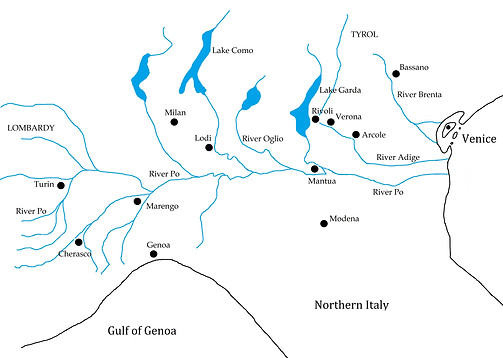
1796-7: Napoleon in Italy
The First Austrian Attempt to Relieve Mantua
Within the first 20 days of the campaign, Napoleon drove the Austrians across the River Po and forced the Sardinians into an armistice. As a result of the armistice at Cherasco, Napoleon secured himself three fortresses and military roads which would aid his advance through Piedmont. By the 10th May, Napoleon was able to secure Lodi and marched on Milan 5 days later. The next step in his campaign was to besiege Mantua, a critical post to hold for operations in Tyrol. The Austrians made four attempts to relieve Mantua.

Map of Italy in the 1800s
(Author's Collection)
The first two attempts were led by General Wurmser, who divided his 50,000 strong force into two – 32,000, under Wurmser, who would march down the River Adige and the remaining 18,000 who would take the route down the east of Lake Garda, led by General Quasdanovich. The Austrian’s assault was so intense that French forces crumbled almost immediately. On the 30th July 1796, the French Council of War met at Roverbella and decided to abandon the siege and attack the two forces head on rather than retreat. Napoleon had a plan – he knew that in order to defeat the relief attempt, he would have to unite his forces to tackle each Austrian force separately. Reluctantly, Napoleons troops abandoned Mantua and set their sights on Quasdanovich’s troops – Wurmser’s biggest mistake was splitting his troops with no means of communication between the two. By the time Wurmser sent reinforcements to aid Quasdanovich, it was already too late and he was swiftly defeated on the 3rd August. Napoleon attacked Wurmser at Castiglione on the 5th August, killing 10,000 Austrians in the process and resulting in a decisive victory for the French, on which Bonaparte himself commented that the Austrians “disappeared like a dream”.
The French continued the siege and the second attempt at relieve Mantua came in early September. Deciding to split his army again, Wurmser left 20,000 men under General Davidovich to defend the approaches to the Tyrol and started marching eastward, then south along the Brenta River. Wurmser led 20,000 men and commanded 10,000 men under General Meszaros in the advance guard, and 5,000 on each flank under Quasdanovich and Sebottendorf. On the 4th September, Davidovich was badly beaten by Napoleon at the Battle of Rovereto. Meanwhile, Napoleon was busy marching his men at speed – 57 miles in 60 hours – to attack Wurmser’s troops by surprise in Bassano, on the 8th September. After this defeat, instead of retreating, Wurmser joined the division under Meszaros and joined their march to Mantua. Realising that Mantua was where the Austrians were headed, Napoleon ordered Massena to march south along the River Adige and block Wurmser’s troops at Legnago. On the 12th September Napoleon entered Mantua with 10,000 troops.
Got a question? Join the discussion in the forum now!
Up Next: The Battle of Arcole and the Second Phase of the siege of Mantua